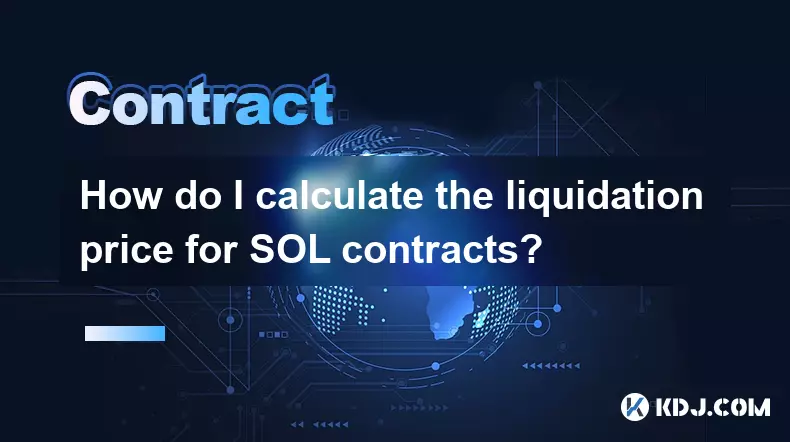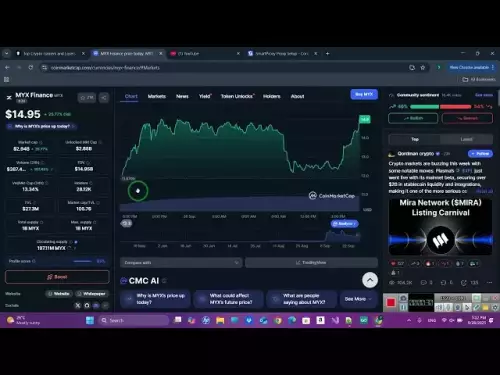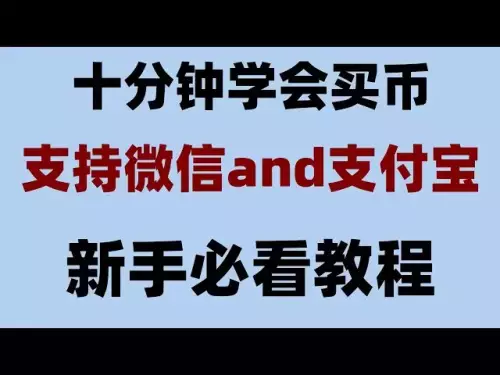-
 bitcoin
bitcoin $109547.008142 USD
0.04% -
 ethereum
ethereum $4011.838726 USD
-0.05% -
 tether
tether $1.000402 USD
-0.01% -
 xrp
xrp $2.798606 USD
0.88% -
 bnb
bnb $970.877944 USD
1.39% -
 solana
solana $202.237275 USD
-0.95% -
 usd-coin
usd-coin $0.999673 USD
0.00% -
 dogecoin
dogecoin $0.229294 USD
-1.15% -
 tron
tron $0.336370 USD
-0.45% -
 cardano
cardano $0.777260 USD
-1.66% -
 hyperliquid
hyperliquid $45.503019 USD
1.73% -
 ethena-usde
ethena-usde $1.000362 USD
0.01% -
 chainlink
chainlink $20.785303 USD
-1.10% -
 avalanche
avalanche $28.755822 USD
-0.11% -
 stellar
stellar $0.358303 USD
-0.48%
How do I calculate the liquidation price for SOL contracts?
The liquidation price in SOL futures is where a leveraged position closes automatically if losses drop equity below maintenance margin, varying by exchange, margin mode, and mark price.
Sep 28, 2025 at 12:18 pm

Understanding Liquidation Price in SOL Futures Trading
1. The liquidation price represents the point at which a leveraged position is automatically closed due to insufficient margin. In the context of Solana (SOL) futures contracts, this occurs when losses erode the collateral backing the trade. Exchanges enforce this mechanism to prevent traders from accumulating debt beyond their deposited margin.
2. Each exchange uses a slightly different formula depending on its risk model, fee structure, and funding mechanisms. However, the core principle remains consistent: if the mark price of SOL reaches a level where the equity in the position falls below the maintenance margin requirement, liquidation is triggered.
3. Traders must account for both initial margin and maintenance margin when estimating liquidation thresholds. While initial margin determines entry capacity, maintenance margin defines the minimum equity needed to keep the position open. Falling below this threshold activates the liquidation engine.
Key Variables in Calculating SOL Liquidation Price
1. Position size, leverage, entry price, and contract type (inverse vs. linear) are foundational inputs. For example, a 10x long position on 100 SOL at $150 requires $1,500 as initial margin. As the price drops, unrealized losses reduce available equity.
2. Funding payments in perpetual contracts can influence effective liquidation levels over time. Although not directly part of the liquidation formula, ongoing funding fees—paid or received—affect account balance and thus buffer against or accelerate liquidation.
Maintenance margin rate is critical: it's typically between 0.5% and 1% on major platforms for SOL contracts. This percentage determines how close the market can move against the position before triggering closure.3. Fees such as taker fees and liquidation penalties may be deducted upon position closure. Some exchanges incorporate these into their liquidation logic, effectively tightening the buffer zone around the theoretical price.
4. Insurance funds and socialized loss models also play a role behind the scenes. Though invisible to individual traders, these systems alter how exchanges manage extreme volatility and failed liquidations, indirectly shaping liquidation behavior during flash crashes.
Differences Between Isolated and Cross Margin Modes
1. In isolated margin mode, traders allocate a fixed amount of collateral to a specific position. Liquidation occurs when that allocated balance is depleted relative to the maintenance margin. This mode allows precise control over maximum loss per trade.
2. Cross margin uses the entire wallet balance as backing for all open positions. While this delays liquidation by pooling resources, it increases systemic risk because one losing position can consume equity supporting others.
On most derivatives platforms, cross margin significantly shifts the liquidation price compared to isolated settings. A long SOL position under cross might survive deeper drawdowns—but jeopardizes the full account.3. Risk limit tiers on certain exchanges further complicate calculations. Higher position sizes enter tiers with increased maintenance margin requirements, meaning the liquidation price worsens disproportionately as exposure grows.
4. Traders using API-based bots must factor in asynchronous updates between mark price, index price, and order book data. Discrepancies during high volatility can cause actual liquidation prices to deviate from calculated values.
Practical Example: Calculating Long and Short Liquidation Prices
1. For a linear perpetual long: Liquidation Price ≈ Entry Price × (1 − Initial Margin Rate + Maintenance Margin Rate). Assuming 10x leverage (10% initial margin), 0.5% maintenance rate, and $160 entry, liquidation occurs near $145.60 without fees.
2. For a short position: Liquidation Price ≈ Entry Price × (1 + Initial Margin Rate − Maintenance Margin Rate). Using same parameters, the trigger would be around $174.40. Shorts face earlier liquidation in rising markets due to unlimited upside risk.
3. Inverse contracts, denominated in crypto rather than USD, require nonlinear math due to BTC or ETH collateralization. Their liquidation formulas involve reciprocal functions, making them more sensitive at extreme price swings.
Always verify results using the exchange’s built-in calculator or risk simulation tool. Manual computations serve as estimates; real-time engine logic includes micro-adjustments based on liquidity layers and tiered rates.Frequently Asked Questions
What causes discrepancies between my calculated liquidation price and the platform’s displayed value?Exchanges use mark price instead of last traded price to prevent manipulation-based liquidations. The difference between mark and spot price, especially during volatility, accounts for most variances in expected triggers.
Does funding rate impact when my SOL position gets liquidated?Funding payments do not directly alter the liquidation price but affect your margin balance periodically. Positive funding on longs adds credits, slightly extending survival time; negative funding accelerates depletion.
Can I adjust my liquidation price after opening a position?Yes, by adding more margin manually (margin injection) or reducing position size. Increasing collateral raises the buffer between current price and the maintenance threshold, pushing the liquidation point further away.
Why did my position liquidate even though the chart shows price didn’t reach the stated level?Liquidations are based on the internal mark price, which combines index data and fair pricing models. It often differs from the trading view or ticker price, particularly during low liquidity or rapid moves.
Disclaimer:info@kdj.com
The information provided is not trading advice. kdj.com does not assume any responsibility for any investments made based on the information provided in this article. Cryptocurrencies are highly volatile and it is highly recommended that you invest with caution after thorough research!
If you believe that the content used on this website infringes your copyright, please contact us immediately (info@kdj.com) and we will delete it promptly.
- Cheap AI Coding Revolution: Gemini 2.5 and the 1 Million Token Dream
- 2025-09-28 20:25:16
- Tether, Circle, and Competition: A Stablecoin Showdown in 2025
- 2025-09-28 20:25:16
- Layer Brett vs. Cardano: A Price Prediction Face-Off for 2025
- 2025-09-28 20:30:03
- Crypto Presale Alert: Unveiling the 500x Potential New Coins of 2025
- 2025-09-28 20:30:03
- Bitcoin Volatility, Whales, and Market Stir: What's the Deal?
- 2025-09-28 20:30:03
- XRP, Ripple, Price Prediction: Decoding the Crypto Crystal Ball
- 2025-09-28 21:05:12
Related knowledge

How do I use the scheduled order feature in Cardano (ADA) contracts?
Sep 28,2025 at 10:18pm
Understanding Scheduled Orders in Cardano Smart ContractsCardano operates on a proof-of-stakes consensus mechanism and uses the Plutus scripting langu...

How do I enable the "scalping-only" mode for Cardano (ADA) contracts?
Sep 24,2025 at 03:19am
Understanding Scalping Strategies in Crypto Derivatives1. Scalping in cryptocurrency trading refers to executing multiple short-term trades within min...

What is the settlement time for Cardano (ADA) contracts?
Sep 28,2025 at 04:18am
Understanding Cardano's Contract Settlement Mechanism1. Cardano operates on a proof-of-stake consensus model known as Ouroboros, which fundamentally i...

How do I add margin to Cardano (ADA) contracts?
Sep 27,2025 at 07:54pm
Understanding Margin in Cardano (ADA) Smart ContractsCardano operates on a proof-of-stake blockchain that supports smart contracts through its Plutus ...

What is the maximum position limit for Cardano (ADA) contracts?
Sep 23,2025 at 11:00pm
Understanding ADA Futures and Derivatives Market Structure1. Cardano (ADA) futures contracts are offered by several major cryptocurrency derivatives e...

What is the maker fee for Cardano (ADA) contracts?
Sep 26,2025 at 09:01am
Understanding Maker Fees in Cardano (ADA) Contracts1. The concept of maker fees applies broadly across decentralized exchanges and smart contract plat...

How do I use the scheduled order feature in Cardano (ADA) contracts?
Sep 28,2025 at 10:18pm
Understanding Scheduled Orders in Cardano Smart ContractsCardano operates on a proof-of-stakes consensus mechanism and uses the Plutus scripting langu...

How do I enable the "scalping-only" mode for Cardano (ADA) contracts?
Sep 24,2025 at 03:19am
Understanding Scalping Strategies in Crypto Derivatives1. Scalping in cryptocurrency trading refers to executing multiple short-term trades within min...

What is the settlement time for Cardano (ADA) contracts?
Sep 28,2025 at 04:18am
Understanding Cardano's Contract Settlement Mechanism1. Cardano operates on a proof-of-stake consensus model known as Ouroboros, which fundamentally i...

How do I add margin to Cardano (ADA) contracts?
Sep 27,2025 at 07:54pm
Understanding Margin in Cardano (ADA) Smart ContractsCardano operates on a proof-of-stake blockchain that supports smart contracts through its Plutus ...

What is the maximum position limit for Cardano (ADA) contracts?
Sep 23,2025 at 11:00pm
Understanding ADA Futures and Derivatives Market Structure1. Cardano (ADA) futures contracts are offered by several major cryptocurrency derivatives e...

What is the maker fee for Cardano (ADA) contracts?
Sep 26,2025 at 09:01am
Understanding Maker Fees in Cardano (ADA) Contracts1. The concept of maker fees applies broadly across decentralized exchanges and smart contract plat...
See all articles









































































